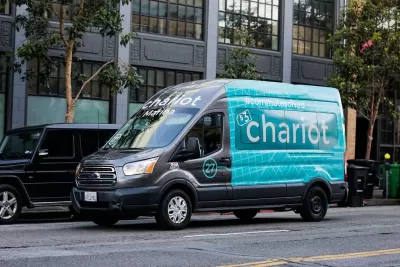Although Ford has stopped its commuter shuttle service, on-demand shuttles have a place in the transportation landscape of the future.

Ford purchased Chariot, the shuttle startup, in 2016, and it recently ceased operations. Nathaniel Giraitis says that the role and potential of dynamic shuttle services like Chariot are important, particularly with the uptick in ride hailing in cities across the country.
One of the challenges with shuttles is how to price them between taxis and public transit. Ride-hailing is pushing travel costs down, but this then puts pressure on shuttle services to be cheaper. The problem is that shuttles do not get the same public subsidies as transit, which makes profitable operations difficult. In addition, the issues that shuttles could address vary by region — from congestion in cities to the first/last mile problem in suburbs and areas with less transit availability.
Giraitis says that shuttle providers should also strive to identify and address the common interest of users. "Regardless of the use case, a focus on the passenger experience and the pain points you are targeting to resolve is key to offering a compelling dynamic shuttle service," he says.
He also suggests that shuttle companies look to partnering with public transit agencies that have the capability to subsidize a service that complements transit. "In the future, we may find that 'premium economy' shuttle services, sponsored by public authorities with digital service partners, are the only ones able to successfully undercut Uber and enable the balance between comfort and efficiency," concludes Giraitis.
FULL STORY: What the closing of Chariot shuttles means for our progress toward new mobility

Planetizen Federal Action Tracker
A weekly monitor of how Trump’s orders and actions are impacting planners and planning in America.

Maui's Vacation Rental Debate Turns Ugly
Verbal attacks, misinformation campaigns and fistfights plague a high-stakes debate to convert thousands of vacation rentals into long-term housing.

Restaurant Patios Were a Pandemic Win — Why Were They so Hard to Keep?
Social distancing requirements and changes in travel patterns prompted cities to pilot new uses for street and sidewalk space. Then it got complicated.

In California Battle of Housing vs. Environment, Housing Just Won
A new state law significantly limits the power of CEQA, an environmental review law that served as a powerful tool for blocking new development.

Boulder Eliminates Parking Minimums Citywide
Officials estimate the cost of building a single underground parking space at up to $100,000.

Orange County, Florida Adopts Largest US “Sprawl Repair” Code
The ‘Orange Code’ seeks to rectify decades of sprawl-inducing, car-oriented development.
Urban Design for Planners 1: Software Tools
This six-course series explores essential urban design concepts using open source software and equips planners with the tools they need to participate fully in the urban design process.
Planning for Universal Design
Learn the tools for implementing Universal Design in planning regulations.
Heyer Gruel & Associates PA
JM Goldson LLC
Custer County Colorado
City of Camden Redevelopment Agency
City of Astoria
Transportation Research & Education Center (TREC) at Portland State University
Jefferson Parish Government
Camden Redevelopment Agency
City of Claremont



























